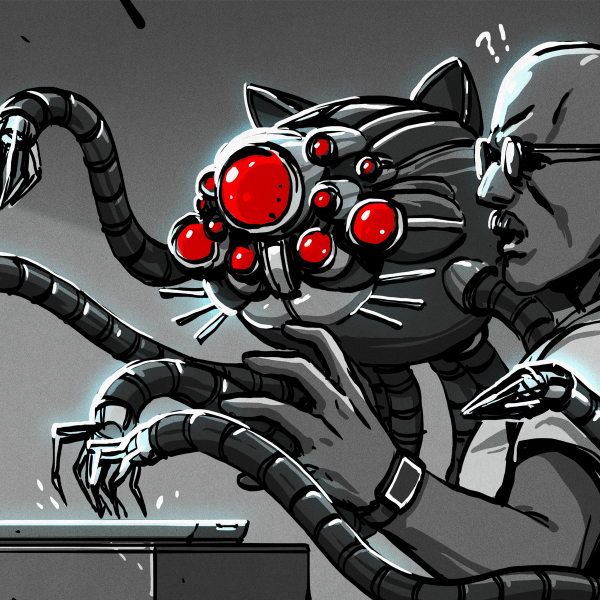![]()
Love the classic brick Game Boy, but hate the low-contrast LCD, terrible battery life, and the inability to play Pokemon Emerald? This one’s just for you. It’s the ultimate DMG Game Boy – a Game Boy Advance SP stuffed (is it stuffed if it’s taking up more room?) into the classic Game Boy enclosure. Forum thread.
Zooming in to a microchip. It starts off with a DSLR and ends up on a scanning electron microscope. This is an older chip, and the CPU you’re using right now probably has much smaller features.
Every movie and every TV show set in space invariably has space helmets with LEDs pointing towards the face. Think how annoying that would be for an astronaut. Here’s how you add LEDs to a space helmet for a nice theatrical effect. Just don’t use it on a real EVA.
Everyone’s favorite crowdfunded space probe can apparently be detected with an 8-foot dish. That’s the same size as an old C-band dish, a.k.a West Virginia wildflowers. We know some of you have one of these out there, so go make a ~2GHz feed horn, grab a USB TV dongle, write it up, and send it in.
Alright, MAME cabinets. Say you want to go old-school and have a CRT. Some arcade games use a vertically oriented display, while other, slightly more modern games use a horizontally mounted display. How do you fix this? Get a big bearing, of course. This one allows a 19″ CRT to be rotated 90 degrees – all you need, really, if you’re switching between Pacman and Mortal Kombat.
Hey mechanical keyboard enthusiasts! Here’s some Hackaday Cherry MX keycaps. Informal interest check in the comments below. Suggestions welcome.

















rotating arcade monitor is brilliant. crt or nothing when it comes to retro gaming.
Using a bearing seems like overkill though. Japanese cabinets (a.k.a. ‘candy cabs’) almost always have monitor rotation mechanisms as standard because they’re designed as generic cabs that can host any game, and the Japanese love them some scrolling shooters and whatnot. (Which often play in ‘tate’ orientation.)
I’ve never personally seen one in action (I’ve got a vintage American-style NEO-GEO MVS cabinet) but they apparently make it pretty damn easy to rotate the behemoth 29″ tri-sync monitors in those candy cabs, so they certainly sound like a model for emulation…pun intended.
Wrenches Keycap WANT! like for real.
Wrenches key cap needs the wrenches to not warp/melt downward. First iteration is nice. Not a fan of the HackADay prize logo
Agreed.
“so go make a ~2GHz feed horn, grab a USB TV dongle, write it up, and send it in.”
Anyone managed to push the e4000 tuners to 2217/2270 MHz? Are there some that can? Otherwise you’ll need to add a downconverter while you’re grabbing stuff…
My dongle tops much lower, but I did notice what appears to be satellite signals while scanning, they have the linear drift and I’m not sure I can explain it otherwise.. Didn’t check what it was though. I should have noted the frequency and googled.
There are several satellites that are lower frequency than 2GHz though.
Registering interest in the jolly wrencher too. Not so much the others. And I’m ok with the wrenches warping down, but perhaps they could warp a bit less. At the moment it seems like they’re 90deg, I’d suggest something more like 30.
I’m thinking the wrenches keycap will look better once it’s a real thing. That, and the proportions of skull to wrenches are just too large to *not* have them all limp and stuff.
I’d put the basic skull on my keyboard. The jolly wrencher seems a little sad with his wrenches all limp
The led helmet stuff is quite fun and the page has decent detail. I think it deserved to have its own post. I don’t get how the bar is set for this Had links post vs a regular one. End of rant.
That image in the microchip zoom video with the 2500 “20nm” transistors / μm² is deceptive and wrong, since a transistor fabricated in 20nm in not nearly as small as 20x20nm and probably never will be that small.
Just for check, the 28nm Nvidia GK110 has 7100 million transistors on a 551mm² die, that makes 12.88 transistors per μm². Now take away 30% of the area for pads etc. and one gets 18 transistors per μm² or 55000nm² per transistor, which is quite far from 400nm² per transistor
It’s not clear what key position the cherry keycaps are for. It’s hard to tell with my Das Keyboard if the keycaps are all the same or if they’re sculpted. Most keyboards use sculpted keycaps so that the typing surface is curved across the front-back axis of the keyboard for a more comfortable typing experience. This reduces production costs because the keys are mounted on a flat plate and the keycaps provide the curve. The old IBM keyboards had all the keycaps the same, but mounted the switches on a curved mounting plate for each keyswitch to give the same effect.
Anyway, if the keycaps on my keyboard are sculpted, you can’t just replace any key on the board with the jolly wrencher. The height of the keycap would be all wrong. The only way it’s compatible with every key position on the keyboard is if the mounting plate is curved.
All this because it seems like it would be cool to replace all 105+ keys….or as many as possible.